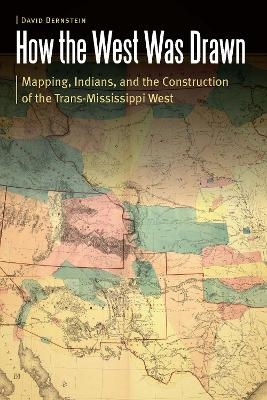
How the West Was Drawn
Mapping, Indians, and the Construction of the Trans-Mississippi West
Seiten
2021
University of Nebraska Press (Verlag)
978-1-4962-2492-7 (ISBN)
University of Nebraska Press (Verlag)
978-1-4962-2492-7 (ISBN)
How the West Was Drawn is a revisionist and interdisciplinary understanding of the global imperial contest for North America’s Great Plains that provides the fine details of the Pawnees’, Iowas’, and Lakotas’ geopolitical and cultural strategies in a rapidly changing world.
How the West Was Drawn explores the geographic and historical experiences of the Pawnees, the Iowas, and the Lakotas during the European and American contest for imperial control of the Great Plains during the eighteenth and nineteenth centuries. David Bernstein argues that the American West was a collaborative construction between Native peoples and Euro-American empires that developed cartographic processes and culturally specific maps, which in turn reflected encounter and conflict between settler states and indigenous peoples.
Bernstein explores the cartographic creation of the Trans-Mississippi West through an interdisciplinary methodology in geography and history. He shows how the Pawnees and the Iowas—wedged between powerful Osages, Sioux, the horse- and captive-rich Comanche Empire, French fur traders, Spanish merchants, and American Indian agents and explorers—devised strategies of survivance and diplomacy to retain autonomy during this era. The Pawnees and the Iowas developed a strategy of cartographic resistance to predations by both Euro-American imperial powers and strong indigenous empires, navigating the volatile and rapidly changing world of the Great Plains by brokering their spatial and territorial knowledge either to stronger indigenous nations or to much weaker and conquerable American and European powers.
How the West Was Drawn is a revisionist and interdisciplinary understanding of the global imperial contest for North America’s Great Plains that illuminates in fine detail the strategies of survival of the Pawnees, the Iowas, and the Lakotas amid accommodation to predatory Euro-American and Native empires.
How the West Was Drawn explores the geographic and historical experiences of the Pawnees, the Iowas, and the Lakotas during the European and American contest for imperial control of the Great Plains during the eighteenth and nineteenth centuries. David Bernstein argues that the American West was a collaborative construction between Native peoples and Euro-American empires that developed cartographic processes and culturally specific maps, which in turn reflected encounter and conflict between settler states and indigenous peoples.
Bernstein explores the cartographic creation of the Trans-Mississippi West through an interdisciplinary methodology in geography and history. He shows how the Pawnees and the Iowas—wedged between powerful Osages, Sioux, the horse- and captive-rich Comanche Empire, French fur traders, Spanish merchants, and American Indian agents and explorers—devised strategies of survivance and diplomacy to retain autonomy during this era. The Pawnees and the Iowas developed a strategy of cartographic resistance to predations by both Euro-American imperial powers and strong indigenous empires, navigating the volatile and rapidly changing world of the Great Plains by brokering their spatial and territorial knowledge either to stronger indigenous nations or to much weaker and conquerable American and European powers.
How the West Was Drawn is a revisionist and interdisciplinary understanding of the global imperial contest for North America’s Great Plains that illuminates in fine detail the strategies of survival of the Pawnees, the Iowas, and the Lakotas amid accommodation to predatory Euro-American and Native empires.
David Bernstein is a historian and photographer.
List of Illustrations
Acknowledgments
Introduction
Part 1: Living in Indian Country
1. Constructing Indian Country
2. Sharitarish and the Possibility of Treaties
3. Nonparticipatory Mapping
Part 2: The Rise and Fall of “Indian Country”
4. The Cultural Construction of “Indian Country”
5. Science and the Destruction of “Indian Country”
Part 3: Reclaiming Indian Country
6. The Metaphysics of Indian Naming
Conclusion
Notes
Selected Bibliography
Index
| Erscheinungsdatum | 25.01.2021 |
|---|---|
| Reihe/Serie | Borderlands and Transcultural Studies |
| Zusatzinfo | 8 illustrations, 46 maps, index |
| Verlagsort | Lincoln |
| Sprache | englisch |
| Maße | 152 x 229 mm |
| Themenwelt | Geschichte ► Allgemeine Geschichte ► Neuzeit (bis 1918) |
| Geisteswissenschaften ► Geschichte ► Regional- / Ländergeschichte | |
| Geschichte ► Teilgebiete der Geschichte ► Kulturgeschichte | |
| Sozialwissenschaften ► Ethnologie | |
| Sozialwissenschaften ► Soziologie | |
| ISBN-10 | 1-4962-2492-2 / 1496224922 |
| ISBN-13 | 978-1-4962-2492-7 / 9781496224927 |
| Zustand | Neuware |
| Haben Sie eine Frage zum Produkt? |
Mehr entdecken
aus dem Bereich
aus dem Bereich
Europa 1848/49 und der Kampf für eine neue Welt
Buch | Hardcover (2023)
DVA (Verlag)
48,00 €
Giordano Bruno - ein ketzerisches Leben
Buch | Hardcover (2024)
C.H.Beck (Verlag)
29,90 €
Kunst und Gesellschaft an der Schwelle zur globalen Welt
Buch | Hardcover (2024)
Klett-Cotta (Verlag)
42,00 €


